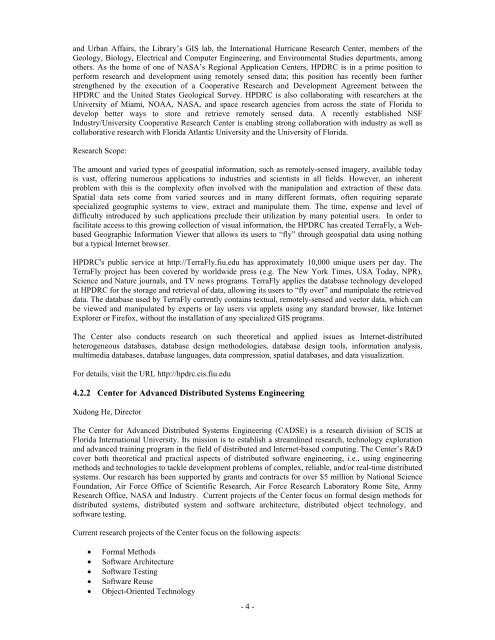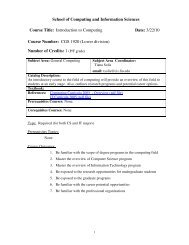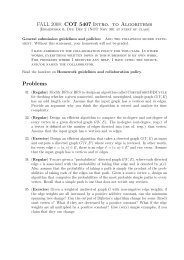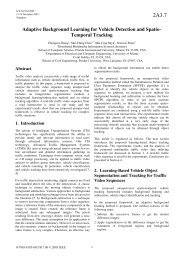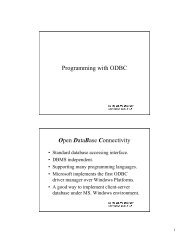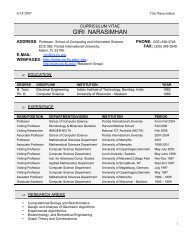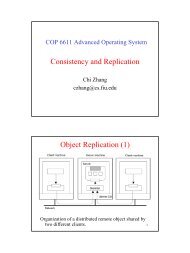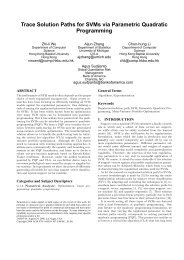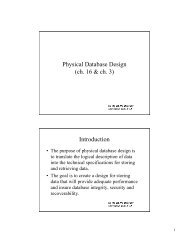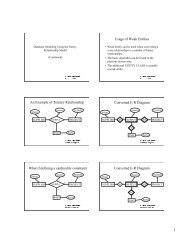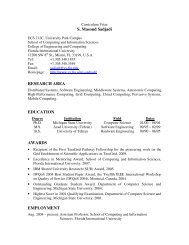Graduate Program Booklet - School of Computing and Information ...
Graduate Program Booklet - School of Computing and Information ...
Graduate Program Booklet - School of Computing and Information ...
Create successful ePaper yourself
Turn your PDF publications into a flip-book with our unique Google optimized e-Paper software.
<strong>and</strong> Urban Affairs, the Library’s GIS lab, the International Hurricane Research Center, members <strong>of</strong> the<br />
Geology, Biology, Electrical <strong>and</strong> Computer Engineering, <strong>and</strong> Environmental Studies departments, among<br />
others. As the home <strong>of</strong> one <strong>of</strong> NASA’s Regional Application Centers, HPDRC is in a prime position to<br />
perform research <strong>and</strong> development using remotely sensed data; this position has recently been further<br />
strengthened by the execution <strong>of</strong> a Cooperative Research <strong>and</strong> Development Agreement between the<br />
HPDRC <strong>and</strong> the United States Geological Survey. HPDRC is also collaborating with researchers at the<br />
University <strong>of</strong> Miami, NOAA, NASA, <strong>and</strong> space research agencies from across the state <strong>of</strong> Florida to<br />
develop better ways to store <strong>and</strong> retrieve remotely sensed data. A recently established NSF<br />
Industry/University Cooperative Research Center is enabling strong collaboration with industry as well as<br />
collaborative research with Florida Atlantic University <strong>and</strong> the University <strong>of</strong> Florida.<br />
Research Scope:<br />
The amount <strong>and</strong> varied types <strong>of</strong> geospatial information, such as remotely-sensed imagery, available today<br />
is vast, <strong>of</strong>fering numerous applications to industries <strong>and</strong> scientists in all fields. However, an inherent<br />
problem with this is the complexity <strong>of</strong>ten involved with the manipulation <strong>and</strong> extraction <strong>of</strong> these data.<br />
Spatial data sets come from varied sources <strong>and</strong> in many different formats, <strong>of</strong>ten requiring separate<br />
specialized geographic systems to view, extract <strong>and</strong> manipulate them. The time, expense <strong>and</strong> level <strong>of</strong><br />
difficulty introduced by such applications preclude their utilization by many potential users. In order to<br />
facilitate access to this growing collection <strong>of</strong> visual information, the HPDRC has created TerraFly, a Webbased<br />
Geographic <strong>Information</strong> Viewer that allows its users to “fly” through geospatial data using nothing<br />
but a typical Internet browser.<br />
HPDRC's public service at http://TerraFly.fiu.edu has approximately 10,000 unique users per day. The<br />
TerraFly project has been covered by worldwide press (e.g. The New York Times, USA Today, NPR),<br />
Science <strong>and</strong> Nature journals, <strong>and</strong> TV news programs. TerraFly applies the database technology developed<br />
at HPDRC for the storage <strong>and</strong> retrieval <strong>of</strong> data, allowing its users to “fly over” <strong>and</strong> manipulate the retrieved<br />
data. The database used by TerraFly currently contains textual, remotely-sensed <strong>and</strong> vector data, which can<br />
be viewed <strong>and</strong> manipulated by experts or lay users via applets using any st<strong>and</strong>ard browser, like Internet<br />
Explorer or Firefox, without the installation <strong>of</strong> any specialized GIS programs.<br />
The Center also conducts research on such theoretical <strong>and</strong> applied issues as Internet-distributed<br />
heterogeneous databases, database design methodologies, database design tools, information analysis,<br />
multimedia databases, database languages, data compression, spatial databases, <strong>and</strong> data visualization.<br />
For details, visit the URL http://hpdrc.cis.fiu.edu<br />
4.2.2 Center for Advanced Distributed Systems Engineering<br />
Xudong He, Director<br />
The Center for Advanced Distributed Systems Engineering (CADSE) is a research division <strong>of</strong> SCIS at<br />
Florida International University. Its mission is to establish a streamlined research, technology exploration<br />
<strong>and</strong> advanced training program in the field <strong>of</strong> distributed <strong>and</strong> Internet-based computing. The Center’s R&D<br />
cover both theoretical <strong>and</strong> practical aspects <strong>of</strong> distributed s<strong>of</strong>tware engineering, i.e., using engineering<br />
methods <strong>and</strong> technologies to tackle development problems <strong>of</strong> complex, reliable, <strong>and</strong>/or real-time distributed<br />
systems. Our research has been supported by grants <strong>and</strong> contracts for over $5 million by National Science<br />
Foundation, Air Force Office <strong>of</strong> Scientific Research, Air Force Research Laboratory Rome Site, Army<br />
Research Office, NASA <strong>and</strong> Industry. Current projects <strong>of</strong> the Center focus on formal design methods for<br />
distributed systems, distributed system <strong>and</strong> s<strong>of</strong>tware architecture, distributed object technology, <strong>and</strong><br />
s<strong>of</strong>tware testing.<br />
Current research projects <strong>of</strong> the Center focus on the following aspects:<br />
� Formal Methods<br />
� S<strong>of</strong>tware Architecture<br />
� S<strong>of</strong>tware Testing<br />
� S<strong>of</strong>tware Reuse<br />
� Object-Oriented Technology<br />
- 4 -


